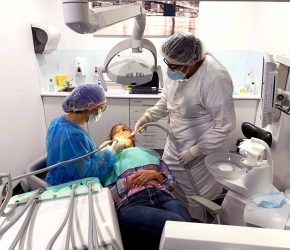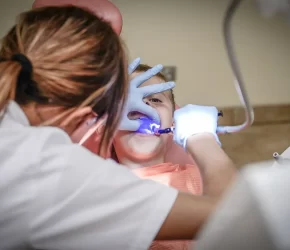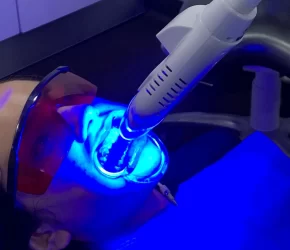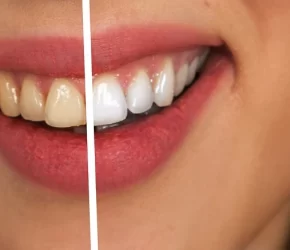“DID YOU KNOW THAT AT DENTALART WE HAVE HUNDREDS OF SUCCESS STORIES, IN THE MOST DIVERSE FIELDS, ALWAYS WITH TOTAL SATISFACTION?”
Our team of dentists is dedicated to providing high quality services, working in all major dental specialities with state-of-the-art equipment. We are genuinely committed to reaching all patients in need of the best dental care.
Besides being related to the teeth, the practice of dentistry is also closely linked to facial aesthetics. We offer aesthetic treatments that restore oral health and self-esteem.
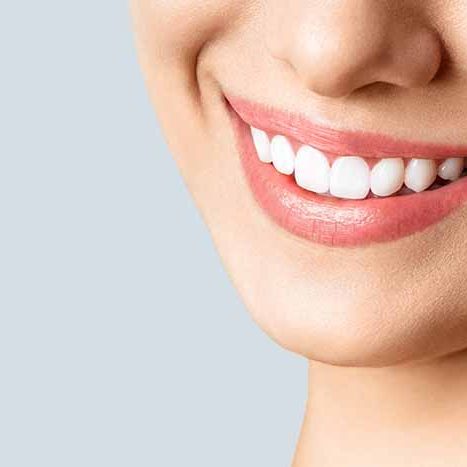
Dental Clinic
The professional team of dentists at DentalArt Clinic is trained to provide quality care through their knowledge of the latest techniques in dental practice. Their dedication to continuous improvement means that they are constantly learning about new methods that provide improvements in oral health.
We also have an Indoor Pharmacy to ensure our patients have regular stocks of every medicine they may need urgently.
All our dental surgeries are performed in an aseptic environment with adequate densification patterns.
We are always available to listen to you and to offer you the best treatments. We want to be your Dentist of choice in Portimão.
We present you with no obligation quotes and flexible payment methods that adapt to your needs.
If you are looking for a Dental Clinic that can provide you with an excellent health experience, don’t hesitate, contact us or use the form to make your appointment. We are in Portimão, Praia da Rocha.
Get in touch with us today +351 932237198
“A smile is a universal language: anytime, anywhere, everyone understands it”
Excellence service. I was very well received, great sense of professionalism. Congratulations Dentalart?️
BRUNO VIEIRAFui por acaso a este consultório odontológico não muito longe de minha residência, fui muito bem recebido por uma jovem gentil e charmosa. O dentista é muito simpático, muito tranquilo, muito reconfortante. O atendimento odontológico foi excelente. Os preços são razoáveis. Eu recomendo altamente este consultório odontológico.
MURIELLE DELEPAUX DUFLOS
CHARLES BONNETThank you Dra. Joyce, the work you did for me was amazing. Extremely satisfied with the service and wholeheartedly recommend DentalArt and Medical Clinic as I know anyone that needs dental work or medical treatment will be as completely satisfied as I was.
PEDRO BOTELHOExcelente atendimento tanto a nível do pessoal administrativo como médico. Atenciosos no trato, na rapidez e eficiência. A médica que me atendeu, Dr.ª Joyce Gomes, fez um trabalho impecável que me deixou muito satisfeito.
NATALIE JOHNSSONDr. Joyce Gomes makes you feel safe and calm with her professional work. I can strongly recommend!
Dental Clinic
Stomatology is dedicated to the prevention, diagnosis and treatment of diseases of the teeth and their supporting structures.
It is within dentistry that we treat oral health problems such as:
Dental caries; Periodontal disease; Loss of teeth; Halitosis; Dental pain; Changes in teeth development; Bad occlusions and much more.
Don’t hesitate, contact us if you have any of these problems or visit our dental clinic in Praia da Rocha, Portimão.
How to order dentist’s vouchers?
According SNS:
What are dentist’s vouchers?
Dentist’s vouchers are guides that give access to a range of dental care. It covers various areas such as prevention, diagnosis and treatment.
How to access?
You should make an appointment to see your GP if you are on the eligible list.
As far as children are concerned, an appointment should only be made for a child under the age of 6 years old inclusive. For the remaining ages, access is decided in a school environment.
Where can I check my dentist’s vouchers?
You can request a dental voucher from your GP at any time, as long as you meet the necessary requirements.
Where can I check my dentist’s vouchers?
You can check your dentist’s vouchers through the personal area of the SNS 24 portal, by going to the ‘My records’ section, clicking on the item ‘Bulletins’ and selecting the tab ‘Oral Health Bulletin’.
Where can I make an appointment for my dental check appointment?
You can use the dental check anywhere in the country, with a doctor who is a member of the National Programme for the Promotion of Oral Health, available from a national directory.
How much does it cost?
It is free of charge.
Who is covered?
Communities covered by the dentist’s vouchers are:
pregnant women followed-up in the SNS
beneficiaries of the Solidarity Supplement
children and young people up to the age of 18, regardless of the school or institution they attend
users with HIV/AIDS infection
users with a suspicious oral cancer lesion
The oral hygiene consultation is open to young people aged 4, 7, 10 and 13.
In addition, the National Programme for the Promotion of Oral Health (PNPSO) enables the provision of dental care to key and especially vulnerable groups and users of the National Health Service (NHS).
What are the different paediatric ages for the dental check?
The ages are divided into:
4 to 6 years old
7 to 9 years old
10 to 12 years old
13 to 14 years old
16 to 18 years old
The 15-year old consultation can be inserted in either the 13-14 or 16-18 age group. For more information see the Dentist’s Voucher for Children guide.
When can I apply for my dental voucher?
You can request a dental voucher from your GP at any time, as long as you meet the necessary requirements.
What are the necessary documents and requirements?
All you need is a duly signed dentist’s voucher and your ID.
Other dental treatments
See this list for everything we can do for you, alone or, as is more common, in integrated services:
- Oral Rehabilitation
- Dental Implant
- Teeth Whitening
- Oral Surgery
- Periodontology
- Orthodontics
- Endodontics
- Dental prosthetics
Oral rehabilitation aims at reconstructing or replacing destroyed teeth with caries or whose structure is very fragile and at risk of disintegration, thus restoring the patient’s chewing, phonetic and aesthetic function.
The oral cavity is complex and composed of gums, teeth and bone. In this sense, it is always essential to think about the oral rehabilitation in order to recompose the whole set that is damaged or lost, seeking to restore the patient’s functional structure, through good chewing and also to create a better standard of aesthetics, which will improve the quality of life and help with self-esteem.
It’s not just a matter of recomposing a specific tooth, but of replacing the whole set of teeth, whether through restoration, implants or removable prosthesis.
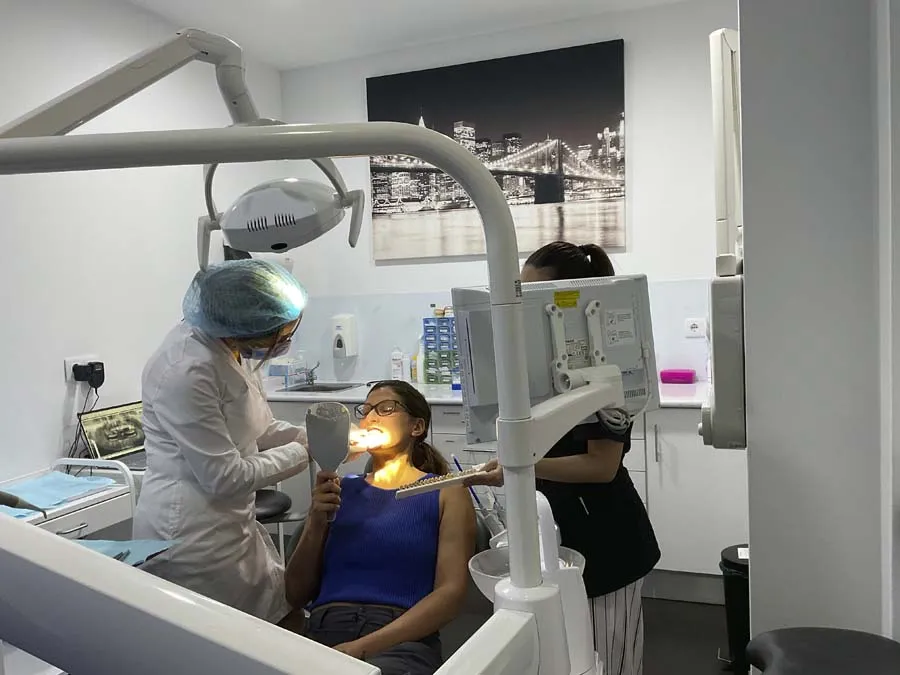
Dental Aesthetics and Oral Rehabilitation
Treatment Plan
Many people seek dental clinics because they want to improve their dental aesthetics.
DentalArt professionals perform a thorough work that begins at the first consultation, where the patient will be examined, photographed and tests that will assist the diagnosis will be requested, such as orthopantomography.
Once this is done, we can propose the best treatment plan to the patient.
There are different ways to replace a tooth or more than one tooth when they have been lost for various reasons. The teeth to be replaced can be fixed or removable.
Lost teeth always need to be replaced, as the lack of just one in the dental arch will affect the functionality of the other teeth.
Choosing restoration, removable or fixed teeth will depend on the most suitable treatment for each patient, which may involve not only the economic factor but also the biological conditions and biotype of each patient. Therefore, a good dental medical analysis is always necessary before deciding on the best type of treatment.
In this text, you will discover which treatments to choose.
Why do I need to replace lost teeth?
There are several reasons why you may need to repair or replace your teeth:
– Pulled out one or more teeth.
– Teeth have been worn down for some reason.
– Lost teeth due to an illness.
– Damaged teeth by tooth decay and dental fillings.
Many people can get used to missing teeth, especially on the sides of the jaw, where the tooth is not so visible. What is important is that the balance of the dental arch remains so that the teeth do not start to lean or move.
Bridge
A bridge is attached in the mouth and replaces two or more teeth. The bridge is sometimes called a bridgework and is joined together in one piece. If a tooth needs to be removed, it can be replaced with a bridge that rests on the teeth on either side.
To be able to replace lost teeth with a fixed bridge, there must be enough teeth remaining in the jaw to provide good support for the bridge. The teeth should also not be too far apart.
Implants
Dental implants are usually titanium metal screws that are operated into the jawbone. The titanium screws act as artificial roots in the jawbone. Once the implant has healed in the jawbone, the crown or bridge can be attached to it.
It is possible to replace a single missing tooth with a crown on an implant. If several teeth are missing, a bridge can be attached to several implants.
Usually, you need to visit the dentist several times before having a bridge or crown fitted. First, the tooth or teeth are ground down and the dentist takes an impression in order to make a model. Then you decide together the colour of the artificial tooth or teeth.
The impression is sent to a dental technician, who fabricates the crown or bridge. The replacement teeth are made of different materials.
Sometimes it is necessary to do one or more tests in the mouth to get a perfect fit. While you wait for the finished crown or bridge, it is usually necessary to temporarily replace the material. When everything is ready, you can try the crown or bridge in your mouth for a few days to feel that everything is fine before it is placed. Finally, the dentist places a cement on the crowns and attaches them to your teeth.
Removable prostheses
If you don’t have many teeth, it can be difficult to replace them with artificial teeth that are stuck. Then you can get a removable denture, a full denture or a partial denture.
In addition to artificial teeth, the prosthesis also consists of an artificial material that replaces gums and jaws. You can insert and remove the prosthesis from your mouth yourself.
The partial denture can be attached with clips or some other attachment device to the teeth left in the jaw. A complete denture replaces the teeth in a completely edentulous jaw.
A full denture in the upper jaw connects like a suction cup to the upper jaw and palate. A complete denture in the lower jaw rests on the edentulous jaw. It can also be attached to ground teeth or implants and is then called a denture.
A partial prosthesis is usually better fixed than a full prosthesis.
If you don’t have teeth anymore
The dentist takes a cast of the edentulous jaw to make a wax cast. This is used to be able to measure where the new teeth should be located. Together with your dentist, you choose the colour and shape of your new teeth.
You need to visit the dentist four to five times before the denture is completely finished. With this method, the fit of the denture is good immediately and you usually avoid major adjustments for a few years.
How do removable prostheses work?
It is different for each person the time it takes to get used to a prosthesis.
It is more difficult to have a removable denture in the lower jaw than in the upper jaw. Dentures in the upper jaw can usually be placed on the palate. In the lower jaw, the tongue and other muscles can move the dentures out of position.
If you get a removable full denture in the lower jaw that doesn’t work well, it may be helpful to insert two implants. The implants have springs that hold the denture in place better, a so-called cover denture. If it works well, it is usually possible to insert more implants and make a bridge that is attached to the implants.
Certain diseases, such as Parkinson’s disease, Sjögren’s syndrome or stroke, can make it more difficult to have removable dentures. So, denture covers can work well.
Implant
In a dental implant, a new artificial tooth or row of teeth is connected directly to the screws that have been operated on in the jaw bone. Sometimes the teeth are attached to small extensions of titanium or other material that protrude from the gum. The extensions are called distances.
You can count on an implant holding up much like your own tooth, if you take good care of it.
Different degrees of lack of teeth require different implants
Before an implant treatment, you will be examined by your dentist. You will discuss your health and explain how the treatment will be carried out.
There are different treatments depending on which teeth are missing:
If you have lost or lost only one tooth, usually only one implant needs to be operated on. The implant then carries a single artificial tooth. This is called a single tooth implant.
If you do not have a tooth in the first row of teeth, it is not enough that the implant is placed in the jawbone. The surrounding tissue must also be shaped to give a natural appearance. Sometimes it is so difficult to get good that a bridge is needed instead to support the surrounding teeth.
If you have lost several teeth, you may get several implants to support a fixed bridge. If you’ve lost large parts of your jaw, your dentist sometimes needs to extend the bridge with artificial teeth to make your face look as it did before.
If you have no teeth in your jaw, it usually takes four to six implants to be able to carry a full row of teeth with artificial teeth. Sometimes more implants are needed.
Preparations for an implant operation
Usually, no pre-treatment is needed if you have a strong, healthy jaw. If you have bad teeth, it may be necessary to have them pulled. Then the jawbone may need to heal before treatment.
If you are a smoker, you should stop smoking well before the operation.
You can get a temporary denture if you are missing a tooth. It fills in the gaps in your teeth and makes it easier to chew.
Sometimes the jaw needs to be built
You can get a bone framework or bone graft if you do not have enough bone for the implants. It is most common for the operation to be performed in the upper jaw.
An X-ray examination of the jaw is performed first to examine the possibilities of operating implants. Sometimes it is done with CT scan, X-ray.
Next, a maxillofacial surgeon operates on bones from another part of the body. Sometimes artificial bone replacement materials are used.
For a minor operation, you will receive local anaesthetic. If the bones are operated on, for example the hip, this is done under anaesthetic
Spacers are fixed to implants
In the second operation, the mucosa opens at each implant and small extensions, called distances, are attached to the implants. The distances go up through the mucous membrane. In these, subsequently, the new artificial tooth or bridge can be screwed in or fixed with cement, usually the second operation is faster than the first.
After the operation of implants
Titanium implants need to heal firmly in the jawbone. The healing time can take up to six months.
In the meantime, you may have temporary teeth. If the implants are very stable, the dentist can sometimes build the artificial teeth into the implants the same day or weeks after the operation.
In case, it is not possible to build fixed temporary teeth, you can wear your old denture again, which has been reshaped to fit the jaw. In smaller spaces, you can sometimes get permanent temporary teeth that rest on the neighbouring teeth immediately after the operation.
Keep your teeth clean
Smoking can make healing difficult after an implant operation.
You will often be given antibiotics after the operation. Sometimes you may need painkillers. As the surgeon punctures the jawbone, there is usually inflammation which passes quickly. It is usually with swelling, tenderness and sometimes there is bleeding.
To keep it clean, you can rinse your mouth with saline and chlorhexidine solution. If you have undergone full jaw surgery, you may need to eat a liquid diet for a few days.
It may seem unusual to have permanent teeth after being without teeth for a long time. Artificial teeth can look new and unusual. Sometimes speech is affected so that you read, for example. But you can find out by reading aloud.
Accompaniment
To check the jawbone around the implants, the dentist must perform an X-ray examination. This is followed by more so that the dentist can compare with previous X-ray examinations whether the implants are in place. During the first two years after surgery, it is important to check if the implants change.
After about two years, the time between X-ray examinations can be extended to, for example, five years if the bone around the implants is healthy.
At regular check-ups at the dentist or dental hygienist, this is checked:
• What the mucous membrane looks like around the implants.
• If there are bacterial coatings, called plates, around the implants and in the artificial teeth.
• What the bite looks like in artificial teeth.
• How the bite fits when you bite together.
• How well the bridge or crown is secured.
Implants that loosen
It is unusual for implants to come loose. If the implant comes loose a few months after the operation, it is usually because they have not grown properly into the bone.
If you drop the implant later, it may be because you chewed too hard. To reduce the risk of congestion, you can wear a brace at night.
Warranty
Most dentists provide a financial guarantee that the crown or bridge that sits on the implants lasts two years.
Implants are guaranteed for at least two years. After that, manufacturers offer different lengths of warranties. If it is a lifetime guarantee, it means that you can get a new implant from the manufacturer if it breaks or becomes loose. In that case, you only have to pay for the surgery and the adjustments.
Preparations for an implant operation
Usually, no pre-treatment is needed if you have a strong, healthy jaw. If you have bad teeth, it may be necessary to have them pulled. Then the jawbone may need to heal before treatment.
If you are a smoker, you should stop smoking well before the operation.
You can get a temporary denture if you are missing a tooth. It fills in the gaps in your teeth and makes it easier to chew.
Crown
If a tooth is so badly damaged that it can no longer be repaired with a minor repair, the dentist may need to repair the tooth further and make a new crown. A crown is an artificial part of a tooth that covers most of the tooth like a cap. The crown is attached to the ground tooth with a cement called, a ceramic material that holds it in place.
Keep cleaning around crowns and bridges
An artificial crown or bridge does not protect teeth from decay or tooth loss. Sometimes bridges can create places between teeth that can be difficult to clean. For example, bacterial coatings easily adhere to the transition between the tooth itself and the artificial crown.
The most important aids for keeping your teeth clean are a soft toothbrush and a fluoride toothpaste. Often, you need more fluoride in the form of tablets, chewing gum or mouthwash. You may also need extra small brushes and dental floss to get access everywhere.
You should see a dental hygienist regularly if you have many crowns or bridges in your mouth. The dentist or dental hygienist can advise you on how to take better care of your teeth.
If you still have some teeth
This can be done in two different ways when getting a new denture. It depends on whether you still have teeth or not.
The dentist makes an impression of the jaw and teeth if there are still teeth in the jaw. The dental technician builds a prosthesis that mimics your own teeth and has an approximate fit to the jaw.
When bad teeth are pulled, you can get your new dentures with a fit that is temporary until your gums and jaws have healed. Then the shape changes and the denture is adjusted until it fits perfectly.
With this method, you do not need to run out of teeth after removed.
The prosthesis should be checked
It is important that you check the prosthesis regularly, at least once a year. It may need to be adjusted. A denture that does not fit well can cause abrasions.
The jaw changes rapidly the first time after teeth are pulled. The denture may need to be adapted to it. A dental technician needs a maximum of a few days to make the necessary adjustments. In the meantime, you can be without a denture.
Sometimes the prosthesis needs to be remade. You can have a copy made of a denture that works well and that you like. It usually works well if what you are copying is not too worn out. You can also order an extra copy of your denture to keep in reserve.
Clean the prosthesis with a brush
A removable denture is easy to clean because you can take it out and brush it. You can use a toothbrush and mild soap. You can brush the gums gently with a soft toothbrush and warm water.
Do not use toothpaste to clean dentures. Toothpaste contains abrasives that can scratch the plastic material and make it easier for bacteria to stick to the denture.
When are implants inadequate?
There are diseases that prevent the placement of implants and sometimes the dentist needs to consult a doctor before the operation. Treatment may need to be postponed, for example in the following situations:
• You have osteoporosis.
• You are taking certain medicines.
• He is being treated for cancer with radiation.
• Their jaws have not fully grown.
• You have few bones in your jaw to be able to insert implants.
If you have cardiovascular disease and use blood-thawed medications, a medical evaluation is required.
Implant surgery
You are operated on once or twice when you receive the implants, depending on how many implants will be inserted.
The operation is usually performed under local anaesthetic and is painless. You may be given sedatives if you are worried about the operation. If you are very worried, you can have the whole treatment under anaesthetic.
The first operation takes one to two hours, depending on how many implants will be inserted.
First, the gums are folded and holes are drilled in the jawbone. The surgeon then attaches the implants to the jawbone. Next, he sews the gums over the implants so that they are not visible.
For about a week, do not use the prosthesis and do not chew where you did the surgery.
Treatment in just one step
Sometimes a treatment is done with just one operation. The surgery takes one to two hours, depending on how many implants will be inserted.
Basically, the same technology is used as in the first operation. But instead of stitching the mucous membrane and covering the implants, the implants or spacers can protrude a few millimetres from the mucous membrane from the start. So no further operation is needed.
Crowns on implants
When the implants are stably fixed and the mucous membrane has healed, the new artificial teeth are placed.
The dentist first makes an impression of the jaw and implant for the dental technician to take a model. On the model, the dental technician then builds the bridge. It’s important that the artificial teeth fit exactly into the implants.
It usually takes about two to four weeks to make the artificial teeth. The dentist attaches the artificial teeth to the implants.
You can’t remove the new teeth by yourself.
Keep your teeth clean
It is just as important to keep implants and new teeth clean as regular teeth clean. The shape of the new teeth can cause food debris and bacterial coatings to stick more easily around the implant and bridge. Ask your dentist or dental hygienist for advice.
You can check your implants and artificial teeth yourself every day when you brush your teeth. Check that your bridges and crowns are stable, that they are intact, that your gums do not bleed or swell and that they do not hurt.
Complications and sequelae of implants
Implants usually work well for a long time. But it can become infected or the pressure from the prosthesis causes the implant to become overloaded and the implant comes loose. If you smoke, this can impair the healing and increase the risk of complications after a while.
Bacterial coating
It can become infected around the implants. This can be compared to losing a tooth. Bacteria can build up around the implants and cause the bone around the screw to break. It can be very difficult to get rid of the bacteria. In this case it may be necessary to remove the implant.
The implant may need to be replaced
If you need a new implant for any reason, a new operation is necessary. The hole in the bone after the lost implant must heal and the tissues must be healthy before a new implant can be operated on. This can take several months.
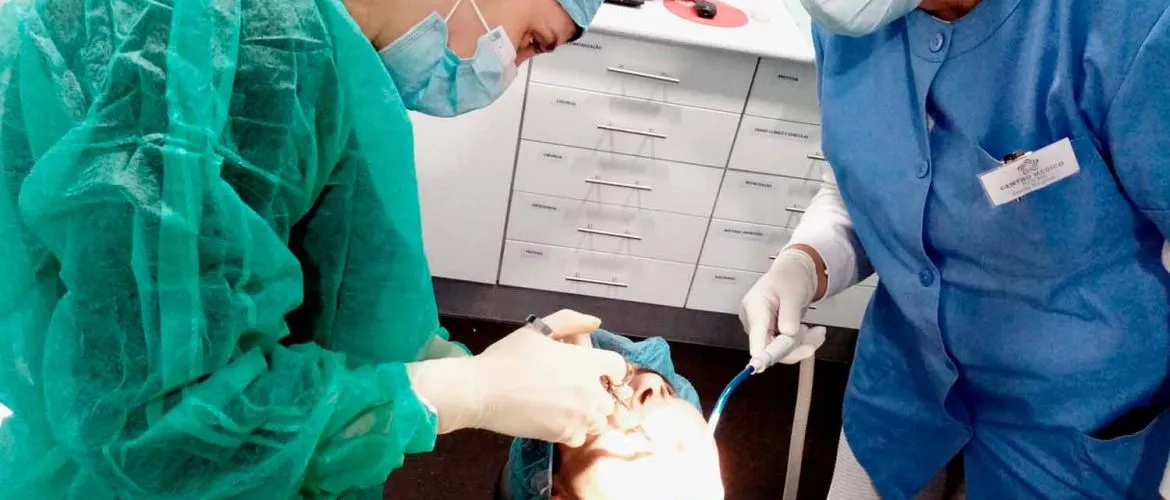
Dental implants are the most recommended option for the rehabilitation of lost teeth. The advantages of this therapeutic option far exceed the choice for removable prostheses. The main reason is easy to explain: dental implants are similar to natural teeth.
An artificial root made from technologically advanced materials will be placed on the jaw bone or jaw and will support ceramic crowns or bridges.
In a dental implant, a new artificial tooth or row of teeth is connected directly to the screws that have been operated on in the jaw bone. Sometimes the teeth are attached to small extensions of titanium or other material that protrude from the gum. The extensions are called distances.
Different degrees of lack of teeth require different implants
Before an implant treatment, you will be examined by your dentist. They will talk about your health and explain how the treatment is done.
There are different treatments, depending on which teeth are missing:
If you have lost only one tooth, usually only a dental implant needs to be applied. The implant then carries a single artificial tooth. It is called implant of a single tooth.
If you do not have a tooth in the first row of teeth, it is not enough for the implant to be placed in the jaw bone. The surrounding tissue should also have a shape that gives a natural appearance. Sometimes it’s so hard to get well that instead a bridge is needed to support the teeth around.
If you’ve lost several teeth, you can get multiple implants to support a fixed bridge. If you no longer have much of your jaw, the dentist sometimes needs to extend the bridge with artificial teeth to make your face look as it used to.
If you have no teeth in your jaw, it usually takes four to six implants to be able to carry a full row of teeth with artificial teeth. Sometimes more implants are needed.
In a simple way, the replacement of lost teeth with a new tooth, by placing an artificial root, is called dental implant. A simple process devised by a team of expertly trained dentists. The choice of materials is of utmost importance and our team works with the best dental implants for maximum quality. Book your appointment::
How much does a dental implant cost?
It depends on various factors, such as the quantity to be placed, the general condition of the jaw and the types of materials to be used. Please ask our team for information and we will be happy to inform you about the prices for your particular case.

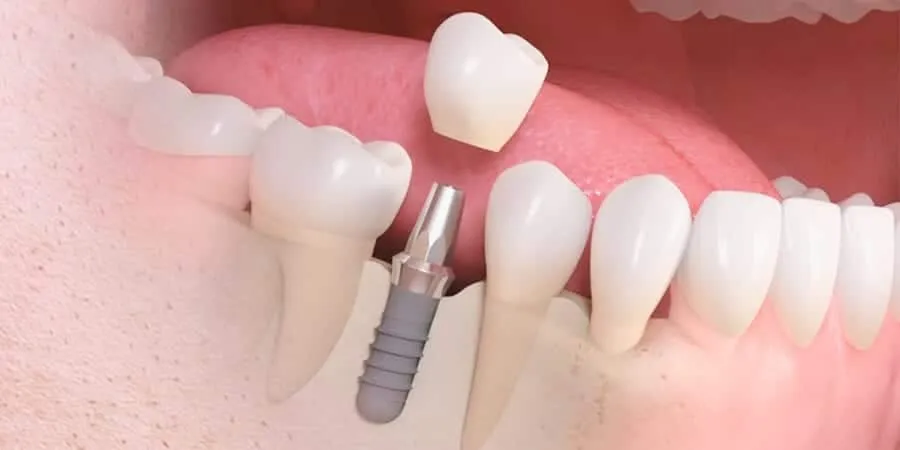
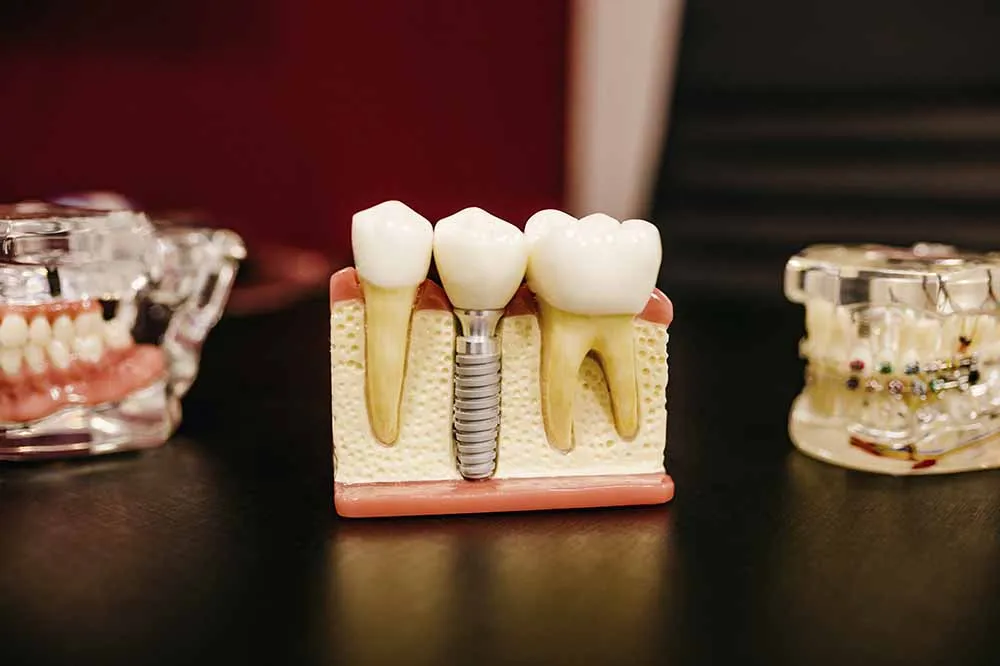

Teeth whitening is completely safe and we guarantee a lasting effect as long as it is done in a controlled environment, in the dental office, or in ambulatory with a medical prescription. Tooth whitening is always an effective treatment. Sometimes it may not fit the patient’s expectations. The result depends on factors such as the type of tooth, the diet, the age of the Patient and his oral hygiene habits. However, it always allows to obtain whiter teeth than the initial state.
Dental whitening is an essentially an aesthetic treatment. It consists of the application of a gel for teeth whitening on the dentition. This gel will lower the tone of the teeth, making them clearer.
Depending on the type of tooth, the patient’s diet, their age and their oral hygiene habits, in a patient considered “ideal”, especially if they are young, a whitening can last 5 or 6 years. Over this time, the teeth gradually darken, with aging. However, they should not be in a tone as dark as the tone prior to treatment. After that time, there is always the opportunity to make a reinforcement and re-whitening the teeth.
The best treatment option always depends on each case, the type of bleaching the patient wants and the level at which we want to reach in terms of the whiteness of the teeth.
Preparations
Before whitening your teeth, you should be examined by a dentist or dental hygienist who will assess whether it is possible to whiten existing discolourations and decide which method is most suitable. If there are holes, they must be repaired and the whole tartar should be removed. It is also important that you have good oral hygiene.
Before having their teeth whitened, they should be examined by a dentist or dental hygienist who will assess whether it is possible to whiten existing discolourations and decide which method is most suitable. The fillings and crowns you have cannot be bleached and are not affected by bleach.
You can lighten your own discolored teeth for a better overall impression if you want to put a crown or bridge in your mouth. If you have an old crown lighter than your own teeth, the teeth around the crown can be leached so that the color difference is reduced.
This is how the treatment works:
 In whitening discolored teeth, different types of whitening gels are used. The bleach substances used penetrate into the enamel and tooth bone. The dark particles that discolor the teeth are broken.
In whitening discolored teeth, different types of whitening gels are used. The bleach substances used penetrate into the enamel and tooth bone. The dark particles that discolor the teeth are broken.
If you think you have discolored teeth, it is important to consult a dentist if your teeth can be whitening and, if so, how to do so.
Depending on the method the dentist uses, it can take from a few hours in the treatment chair to a few days or weeks of treatment at home. In the case of more severe discolorations, it may take even longer.
Bleaching is a chemical process. Bleach penetrates enamel and tooth bone. In this place, discolored dark substances are decomposed into smaller, non-colored substances.
Before starting treatment, the color of the teeth should be documented. This can be done by the dentist, for example, by taking a picture of all the teeth that will be bleached. In this way, you can more easily assess how was the treatment later.
Most common gel
In teeth whitening, the most commonly used gels are those that, among other things, contain the substances urea peroxide or hydrogen peroxide. The bleach gels used on the bleach rails also contain potassium nitrate and fluoride, which should lessen the problem of irritation during treatment.
Different types of bleach
Dental bleaching agents are cosmetic products. They cannot be used by persons under 18 years of age.
Here are some different types of preparations used for teeth whitening:
Bleaching agents for dental care that can contain a maximum of six percent hydrogen peroxide or the equivalent potency of another agent.
Bleaching gels that cannot contain more than six percent hydrogen peroxide or the equivalent potency of another agent. You can use the gel yourself after being examined.
Disposable strips and disposable rails covered with hydrogen peroxide gel. They are used in home treatment.
Varnish that contains hydrogen peroxide or urea peroxide and that is brushed on the teeth during treatment at home.
Bleach sold in department stores or over the Internet. They may contain substances such as sodium perborate or sodium chlorite. It is often unclear in what amount. It can also contain acidic solutions such as citric acid. Always talk to your dentist or dental hygienist before using products purchased online.
Agents that contain more than 0.1 percent hydrogen peroxide can only be sold to dentists. This also applies to the corresponding power force of another
First treatment at the dentist
For the first time in each treatment cycle, you will need the help of a dentist to use the whitening. You can also get treatment from a dental hygienist under the supervision of a dentist. After that, you can take bleach home to finish the treatment yourself.
If you receive treatment in a dental clinic, the teeth are prepared in different ways, depending on the whitening to be used. A rubber cloth is often used to isolate the teeth, so that the gums and mouth are protected against strong gels.
The treatments that are done in the dental clinic take about an hour, but it is usually necessary to go back once or twice more to repeat the treatment. It depends on how satisfied you and your dentist are with the results after the first time.
The plastic rail is filled with gel
First, an impression of the teeth is made in the dental clinic if you are going to whitesize your teeth at home. With the help of molding, a model is made in which a plastic splint is made that fits your teeth. You fill the plastic splint with bleach gel and use one to two hours a day, or at night if it is too difficult to have during the day.
Frequently, three to four days of treatment may be sufficient. It may be necessary to treat your teeth for up to two weeks if you have severe discoloration.
It is not possible to say that one method is better than the other. Treatment in the clinic is faster, but the result is no better than the treatment you do at home. So far, there is little research on the efficacy of clinical bleaching and the duration of the outcome.
Whitening of filling teeth
When the teeth are to be bleached, the technology is different. The most reliable and risk-free method is a gel containing hydrogen peroxide. Treatment is repeated at intervals of three to five days until the result is good. Usually does the treatment two to three times.
The post is usually replaced after three to seven days. The insert may need to be replaced one or more times before the result is good. Sometimes the result may be better if this treatment is combined with teeth whitening in the usual way.
When you have a tooth with root, the result is almost always good. Often, the tooth darkens again over time, but then treatment can be repeated.
The root can be severely damaged when you whiten filling teeth, although this is rare. Usually you have no symptoms and in some cases the changes are only discovered long after the tooth has bleached, and only when the dentist takes an X-ray.
Possible Problems
When you whiten your teeth, your gums can become swollen, a little sore or irritated. It is important that you pause the treatment for one to two days or until the gums have healed.
It is the contact of the bleaching gel with the gums that can be irritating, especially when using stronger preparations or when the plastic splints do not fit well.
Problems with toothache
You may also experience discomfort in the form of rashes when whitening your teeth, but they disappear. Irritation occurs due to penetration of the bleach into the tooth and the creation of an inflammation in the pulp. Symptoms usually disappear within one to two days if you discontinue treatment.
Do not eat or drink anything with strong colors during treatment and a few days later. It can be, for example, red wine and blueberry.
After teeth whitening, these are usually treated with fluoride because tooth enamel needs to be strengthened.
Will it look good after a treatment?
How good the result of bleaching is depends, among other things, on the following:
• What kind of discoloration do you have.
• Discolorations have been present for how long.
• What is the original color of the tooth.
If you have fillings that need to be replaced after bleaching, you should wait one to two weeks after the end of treatment. It is important that the color of the teeth stabilizes, but also that there is no bleach residue. These residues prevent the plastic filling materials used from solidifying properly.
Lightening treatment usually lasts from one to three years. You can combine with your dentist to repeat treatment when necessary.
Studies have not yet been done to show how teeth are affected by repeated whitening. But so far there is no indication that there are health risks, only treatment is done properly, without very strong funds.
When is treatment inappropriate?
If you have problems with burns in the form of neck of teeth, surfaces of unprotected roots, damage to the brush or fine enamel, you should not whiten your teeth. With these problems, the risk of side effects in the form of irritability increases.
Do not whiten your teeth if you smoke or smoke snuff. Tobacco dyes can worsen the outcome of treatment. Bleach can aggravate the damage that tobacco can cause to the oral cavity.
Do not whiten your teeth if you are pregnant or nursing. There are no studies showing whether the bleach affects the fetus or the baby.
It is risky to whitening the teeth without having contact with the dentist. You cannot judge for yourself which solution is appropriate for use. Only trained dental staff can do that.
Most discolorations can be bleached
Teeth with yellow or brown discoloration are usually easier to lighten than others.
Metal discolorations are almost impossible to bleach, such as amalgam fillings. The same applies to teeth that have suffered blow or injury and where the pulp has been damaged. These teeth are usually darker or more yellow than the other teeth.
Various causes of discolored teeth
The fact that we have different colors in the teeth is totally natural and many are darker in color over the years. The color of the teeth can also be changed by strong dyes of tobacco, food and beverages that penetrate the enamel and tooth bone.
Over time, the filling teeth can acquire a bluish-gray discoloration.
Discolorations can also occur before permanent teeth appear in the mouth. The most common causes are chronic diseases with high fever in young children, or situations in which the baby’s teeth are exposed to blows or damage that affect the growth of the enamel of new teeth.
It may also be due to hereditary diseases that affect the teeth when they form in the jaws, or when the child has taken a certain type of antibiotic, tetracyclines.
May cause discoloration if children up to six years of age drink water that contains too much fluoride. The most common is to appear as white spots on the teeth.
This is especially true if the child drinks water from a well whose water has not been analyzed.
Do not hesitate to contact us to request more information. Or make an appointment.
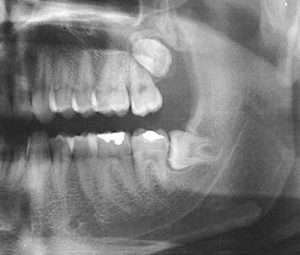
Oral Surgery is the specialty of Dentistry dedicated to the surgical
treatment of structures related to the oral cavity. Dental extractions
are the most common surgical acts, involving teeth that cannot be
maintained due to extensive caries, root fracture
or loss of bone support.
Some oral surgeries involve repositioning the jaw. In other cases, oral surgery may involve the removal of a tumour. Oral surgeries can be performed by any of several types of dental specialists, including endodontists, periodontists, and prosthodontists.
If you need any treatment that requires Oral Surgery, do not hesitate, book your appointment:
Wisdom teeth
Included wisdom systems are one of the most complex extractions since, often due to lack of space, it remains inside the maxilla or mandible.
For this reason, the clinical and radiographic examination must be very careful, in order to avoid sequelae.
Implants
The surgery also includes the placement of dental implantsto replace tooth loss. The technique should also be carefully evaluated in order not to affect important structures.
However, this area is not limited only to dental extractions or implant placement, but also covers several other surgical interventions, in cases of oral cavity pathologies, as is the case:
- Enucleation of maxillary bone cysts;
- Excision of lesions in the oral cavity;
- Lingual or labial frenectomies (correction of the tongue or lip frenulum);
- Exposure of impacted teeth for orthodontic traction;
- Surgical drainage of abscesses;
- Biopsies of oral hard or soft tissues.
Phases of Oral Surgery Treatment:
1. Diagnosis.
2. Surgery.
3. Postoperative consultation.
Periodontology is the Dental Specialty dedicated to the diagnosis and treatment of diseases that affect the supporting tissues of the teeth: Gingiva, Alveolar Bone and Periodontal Ligament (fibers that join the tooth to the bone).
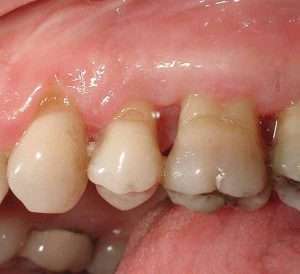
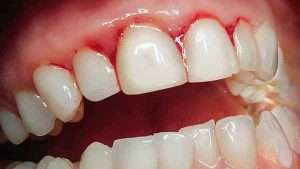
If you need any Periodontology treatment, do not hesitate, book your appointment:
The most common periodontal diseases are Gingivitis (inflammation of the gums) and Periodontitis (inflammation that leads to loss of bone and gums), the latter being one of the main causes of tooth loss in adults.
These are diseases resulting from the accumulation of bacteria in the tissues of the oral cavity, affecting the structures responsible for maintaining the firmness of teeth in the maxilla and mandible.
The procedures involved in this specialty are, as a rule, minimally invasive (shaving, root planing and bacterial decontamination) and with excellent results, significantly increasing the longevity of the dentition.
Periodontal disease aggravates several systemic diseases such as diabetes, cardiovascular disease, respiratory disease, osteoporosis, Alzheimer’s, premature birth, stroke, among others.
DentalArt Medical Clinic
(Former Rocha Medical Center)
+351 932 237 198 / +351 282 041 932
Loja 8, Edifício Plaza Real, Estrada da Rocha, 8500-810 Portimão

Crown

Implants hold artificial teeth
It is possible to replace a single lost tooth with a crown on an implant. If several teeth have been lost, a bridge can be attached to several implants.

Keeping crowns and bridges clean
The most important tools for keeping your teeth clean are a soft toothbrush and fluoride toothpaste. Extra fluoride is often needed in the form of tablets, chewing gum or mouthwash. You may also need extra small brushes and floss to get everywhere.
You should see a dental hygienist regularly if you have a lot of crowns or bridges in your mouth. The dentist or dental hygienist can advise you on the best way to care for your teeth.

Removable prosthesis
In addition to artificial teeth, a denture is also made of an artificial material that replaces the gums and jawbone. You can insert and remove dentures from your mouth yourself.
The partial denture can be attached to the remaining teeth in the jaw with clasps or some other fixing device. A complete denture replaces the teeth in a completely edentulous jaw.
A complete denture in the upper jaw attaches like a suction cup to the upper jaw and the palate. A complete denture in the lower jaw rests on the edentulous jaw. It can also be fitted to ground teeth or implants and is called a cover denture.
A partial denture usually fits better than a full denture.

If you no longer have teeth
You will have to visit the dentist four to five times before the denture is completely ready. With this method, the fit of the denture will be good straight away and you will usually avoid major adjustments for a few years.

How do removable prostheses work?
It is more difficult to wear a removable denture in the lower jaw than in the upper jaw. Dentures in the upper jaw can often be attached to the palate. In the lower jaw, the tongue and other muscles can move the denture out of position.
If you get a removable full denture in your lower jaw that doesn’t work well, it may help to have two implants placed. The implants have clasps that hold the denture more securely in place, called a cover denture. If it works well, it is usually possible to insert more implants and make a bridge that attaches to the implants.
Some diseases, such as Parkinson’s disease, Sjögren’s syndrome or stroke, can make removable dentures more difficult. In these cases, denture covers can work well.

Implants
You can expect an implant to last as long as your own tooth if you take good care of it.
Different degrees of tooth loss require different implants
Before an implant treatment, you will be examined by your dentist. You will have a talk about your health and look at how the treatment is done.
There are different treatments depending on the missing teeth:
– If you are missing or have lost only one tooth, it is usually necessary to insert only one implant. The implant then carries a single artificial tooth. This is called a single dental implant.
– If you are missing a tooth at the end of your jaw, it is not enough that the implant is attached to the jawbone. The surrounding tissue must also be shaped to give a natural appearance. Sometimes it is so difficult to get right that a bridge is needed to support the surrounding teeth.
– If you have lost several teeth, you may have several implants to support a fixed bridge. If you’ve lost large parts of your jawbone, your dentist sometimes needs to extend the bridge with artificial teeth to make your face look the same as before.
– If you are completely edentulous in one jaw, four to six implants are usually needed to support a full row of artificial teeth. Sometimes more implants are needed.

Warranty
Implants are guaranteed for at least two years. After that, manufacturers give different lengths of guarantee. If it is a lifetime guarantee, it means that you can get a new implant from the manufacturer if it breaks or becomes loose. You will then have to pay for the operation and fit yourself.

Preparation for an implant operation
If you are a smoker, you should stop smoking well before the operation.
You can have a temporary denture if you are missing teeth. It fills the gaps between your teeth and makes chewing easier.

Implant surgery
The operation is usually done under local anaesthetic and is painless. You may be given sedatives if you are worried about the operation. If you are very worried, you can have the whole procedure done under anaesthetic.
The first operation takes one to two hours, depending on how many implants are to be inserted.
First, the gums are folded back and holes are drilled in the jaw. The surgeon then attaches the implants to the jawbone. The gums are then sewn over the implants so that they are not visible.
For about a week, you will not wear your dentures and you should not chew where you have had the operation.

One-step treatment
Essentially the same technique is used as in the first operation. But instead of sewing over the mucous membrane and covering the implants, the implants or spacers can protrude a few millimetres from the mucous membrane from the start. A second operation is not necessary.

Getting your teeth done
The dentist first takes an impression of the jawbone and implants so the dental technician has a model. The dental technician then builds the bridge on the model. It’s important that the artificial teeth fit exactly on your implants.
It usually takes about two to four weeks to make the artificial teeth. The dentist attaches the artificial teeth to the implants.
You cannot remove the new teeth by yourself.

Keep your teeth clean
You can check your implants and artificial teeth every day when you brush your teeth. Check that your bridges and crowns feel stable, that they are in one piece, that your gums are not bleeding or swollen and that they are not painful.

Complications and sequelae of implants

Bacterial coating

Bridge
In order to replace lost teeth with a fixed bridge, there must be enough teeth in the jaw to provide good support for the bridge. The teeth should also not be too far apart.
The bridge can be fixed in two ways. Either directly on the uncut teeth or the dentist grinds the teeth so that the bridge can be threaded and fixed with a cement.

Assembling a bridge
The impression is sent to a dental technician, who makes the crown or bridge. The replacement teeth are made of different materials.
You may need to have one or more tests done in your mouth to make sure the fit is perfect. While you wait for the finished crown or bridge, you will usually have a temporary plastic replacement. When everything is ready, you can try the crown or bridge in your mouth for a few days to make sure everything feels right before it’s fixed. Finally, your dentist will place a cement on the crowns and attach them to your teeth.

Lifetime of crowns and bridges
Most dentists give a financial guarantee that a fixed crown or bridge will last for two years.

If you still have teeth
The dentist will take an impression of your jawbone and teeth if there are any teeth left in your jaw. The dental technician will construct a denture that mimics your own teeth and fits your jaw roughly.
Once the bad teeth have been extracted, you can have your new dentures fitted temporarily until your gums and jaw have healed. The shape will then be changed and the denture adjusted until it fits perfectly.
With this method, you don’t have to be left without teeth after extraction.

The prosthesis needs to be checked
The jaw changes rapidly in the first days after the teeth are extracted. The denture may need to be adjusted accordingly. A dental technician will need a few days at the most to make the necessary adjustments. In the meantime you may be left without dentures.
Sometimes dentures need to be remade. You can have a copy made of a denture that works well and that you like. This is usually fine if the one you copy is not too worn out. You can also order an extra copy of your dentures to keep in reserve.

Cleaning dentures with a brush
Do not use toothpaste to clean dentures. Toothpaste contains abrasives that can scratch the plastic material and make it easier for bacteria to adhere to the denture.

When are implants unsuitable?
– You have osteoporosis.
– You are taking certain medicines.
– You are being treated for cancer with radiation.
– Your jaws have not yet finished growing.
– You have too little bone in his jaw to be able to insert implants.
If you have any cardiovascular disease and are taking medication to thin your blood, you will need to be assessed by a doctor.

Sometimes the jaw needs to be reconstructed
First, an x-ray of the jaw is taken to check the possibility of implant surgery. Sometimes this is done with a computed tomography (CT) scan.
An oral surgeon then operates with bone from another part of the body. Sometimes artificial bone substitutes are used.
For a minor operation, you will be given a local anaesthetic. Hip bones, for example, are operated on under general anaesthetic.

The implant may need to be replaced

The spacers are attached to the implants

After implant surgery
In the meantime, you will have dentures and will not have to be toothless. If the implants are very stable, the dentist can sometimes build artificial teeth on the implants the same day or weeks after the operation.
Seven to ten days after the operation, you can wear your old dentures again, which have been reshaped to fit your jaw. In smaller spaces, you can sometimes get temporary teeth that rest on the abutment immediately after the surgery.

Keep your teeth clean
You will often be given antibiotics after the operation. Sometimes you may need painkillers. As the surgeon has punctured the jaw bone, you will often have inflammation which will soon go away. There is usually swelling, tenderness and sometimes bleeding.
To keep it clean, you can rinse your mouth with saline solution and chlorhexidine. If you have had an operation on a whole jaw, you may need to eat a liquid diet for a few days.
It may be unfamiliar to have fixed teeth after being edentulous for a long time. Artificial teeth can feel new and unfamiliar. Sometimes speech is affected so that you can read, for example. But you can train this by reading aloud.

Follow-up and aftercare
After about two years, the time between X-rays can be extended to, say, five years if the bone around the implants is healthy.
This is checked at regular check-ups with the dentist or dental hygienist:
– The appearance of the mucous membrane around the implants.
– If there are bacterial deposits, known as plaque, around the implants and on the artificial teeth.
– The appearance of the bite of artificial teeth.
– How the bite feels when you bite together.
– How well the bridge or crown fits.

Implants that loosen
If you lose the implant later, it may be because you chewed too hard. To reduce the risk of overloading, you can wear a bed splint at night.
Orthodontics

is the area of human health that studies and treats the stomatognathic system that includes the face, neck and oral cavity, including bones, masticatory muscles, joints, teeth and tissues. Its optimal function as a whole contributes to the oral health of the patient.
Oral health means the absence of stomatological diseases, as well as the correct functioning, stability and even aesthetics of the entire stomatognathic system. It is now well known that oral health has serious implications for human health, both of which are inseparable.
As well as being related to the teeth, orthodontics is also closely linked to facial aesthetics. Our role is to propose aesthetic treatments that satisfy the patient, in addition to restoring oral health.
Endodontics takes care of the internal structure of each tooth through prevention, diagnosis and treatment and its purpose is to treat the tooth as a whole, maintaining or recovering the health of the tissues that are inside the teeth and directly around it.
In some cases when there is a very acute pain where the patient complains of not being able to eat, sleep and the pain is so intense that extends to the ear and head, possibly we are facing a caries that reaches the dental pulp and the nerve of the tooth. In these situations the treatment to be done is a devitalization, and should be cleaned the entire region of the tooth where the caries is completely removed, as well as the pulp of the tooth, because in this case, it was contaminated by numerous bacteria resulting from active and untreated caries.
After disinfection of the root canal, which is the place through which the pulp passes, this space is sealed inwardly with a biocompatible material and the tooth can finally be rehabilitated by a conventional restoration or a ceramic piece that will bring better durability and resistance to the tooth.
According to the Portuguese Dental Association, the word endodontics comes from Greek and means inside (endo) the tooth (dontia). Normally a tooth that has undergone non-surgical endodontic treatment can last for life and never need another intervention. Nevertheless, in occasional cases, the tooth may fail to heal. The tooth may in these cases become painful or diseased months or even years after an apparently successful treatment. In these situations, endodontic surgery can save the tooth. This is a surgical intervention to remove all inflamed and infected tissues and the root tip, and a sealing material is placed in the terminal part of the root canal. The apical surgery can be performed with the aid of an operating microscope, which exceptionally increases the precision of all the steps, contributing decisively to the success of this technique.
Endodontics is the branch of dentistry concerned with the pathology of the dental pulp and tissues surrounding the roots and their treatment. The dental pulp is the organ (composed of nerves, blood vessels, etc.) that is found inside the tooth (root canal) and is commonly, though erroneously, known as “nerve”. Years ago, teeth with problems in the dental pulp were commonly extracted. Today, thanks to all the scientific and technological advances, the treatments available can almost always save these teeth, keeping their chewing function and aesthetics unaltered. You can always book an Endodontic treatment on the following form

Artificial teeth – Dental prosthesis
There are different types of artificial teeth. You can replace anything from one tooth to a whole row of teeth. Artificial teeth can be fixed or removable.
Lost teeth do not always have to be replaced. Ask your dentist if you need to replace the tooth or teeth or you can do it later.
Tooth replacement treatment differs depending on what suits you and what is possible. If you need a prosthesis, it is good to know that a fixed prosthesis with implants is more expensive than a removable prosthesis.
This text tells you which treatments you can choose from. It deals with fixed dentures on your own teeth, removable dentures or dentures that are screwed onto implants in your jaw.
Dental prosthesis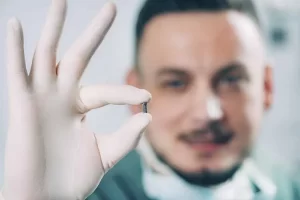
Why might I need artificial teeth?
There are several reasons why you may need to have your teeth repaired or replaced:
– You’ve already pulled one or more teeth.
– Your teeth are worn down by the effects of, for example, pressure or acidic drinks.
– You lost teeth due to periodontal disease.
– Your teeth have been damaged by decay and fillings, so they need to be extracted and replaced.
– You are missing certain teeth or has abnormally shaped teeth.
Many people can get used to having a gap in their teeth, especially on the sides of the jaw where the gap is not very visible. The important thing is that the balance of the teeth remains so that the teeth do not start to tip or move.
Crown and bridge are common treatments
A filling is made by replacing the broken part of the tooth with one of these:
– A glued plastic filling.
– A bonded veneer, which is a thin porcelain shell.
– An inlay that is glued into an earthen groove in the tooth.
– A lid bonded with a porcelain or metal core.
Crown and bridge are common treatments
A filling is made by replacing the broken part of the tooth with one of these:
– A glued plastic filling.
– A bonded veneer, which is a thin porcelain shell.
– An inlay that is glued into an earthen groove in the tooth.
– A lid bonded with a porcelain or metal core.
Bridge
A bridge is attached to the mouth and replaces one or more teeth. The bridge is sometimes called a bridgework and is joined together in one piece. If a tooth has to be pulled out, it can be replaced by a bridge that rests on the teeth on either side of the gap.
In order to replace lost teeth with a fixed bridge, there must be enough teeth in the jaw to provide good support for the bridge. The teeth should also not be too far apart.
The bridge can be fixed in two ways. Either directly on the uncut teeth or the dentist grinds the teeth so that the bridge can be threaded and fixed with a cement.
Implants hold artificial teeth
Dental implants are usually screws made of titanium metal that are operated into the jawbone. The titanium screws act as artificial roots in the jawbone. Once the implant has healed in the jawbone, the crown or bridge can be attached to it.
It is possible to replace a single lost tooth with a crown on an implant. If several teeth have been lost, a bridge can be attached to several implants.
Keeping crowns and bridges clean
An artificial crown or bridge does not protect your teeth from decay or tooth loss. Bridges can sometimes create gaps between teeth that can be difficult to clean. For example, bacterial deposits easily stick to the transition between your own tooth and the artificial crown.
The most important tools for keeping your teeth clean are a soft toothbrush and fluoride toothpaste. Extra fluoride is often needed in the form of tablets, chewing gum or mouthwash. You may also need extra small brushes and floss to get everywhere.
You should see a dental hygienist regularly if you have a lot of crowns or bridges in your mouth. The dentist or dental hygienist can advise you on the best way to care for your teeth.
Removable prosthesis
If you are missing many teeth, it may be difficult to replace those teeth with fixed dentures. In this case, you may have a removable denture, either a full denture or a partial denture.
In addition to artificial teeth, a denture is also made of an artificial material that replaces the gums and jawbone. You can insert and remove dentures from your mouth yourself.
The partial denture can be attached to the remaining teeth in the jaw with clasps or some other fixing device. A complete denture replaces the teeth in a completely edentulous jaw.
A complete denture in the upper jaw attaches like a suction cup to the upper jaw and the palate. A complete denture in the lower jaw rests on the edentulous jaw. It can also be fitted to ground teeth or implants and is called a cover denture.
A partial denture usually fits better than a full denture.
If you no longer have teeth
The dentist takes an impression of the edentulous jaw to make a wax cast. This is used to measure where the new teeth will sit. Together with your dentist, you choose the colour and shape of your new teeth.
You will have to visit the dentist four to five times before the denture is completely ready. With this method, the fit of the denture will be good straight away and you will usually avoid major adjustments for a few years.
How do removable prostheses work?
The time it takes to get used to a denture is different for each person.
It is more difficult to wear a removable denture in the lower jaw than in the upper jaw. Dentures in the upper jaw can often be attached to the palate. In the lower jaw, the tongue and other muscles can move the denture out of position.
If you get a removable full denture in your lower jaw that doesn’t work well, it may help to have two implants placed. The implants have clasps that hold the denture more securely in place, called a cover denture. If it works well, it is usually possible to insert more implants and make a bridge that attaches to the implants.
Some diseases, such as Parkinson’s disease, Sjögren’s syndrome or stroke, can make removable dentures more difficult. In these cases, denture covers can work well.
Preparation for an implant operation
Usually there is no need for pre-treatment if you have a healthy and strong jaw bone. If you have bad teeth, they may need to be extracted. In this case, the jawbone may need to heal before treatment.
If you are a smoker, you should stop smoking well before the operation.
You can have a temporary denture if you are missing teeth. It fills the gaps between your teeth and makes chewing easier.
Cleaning dentures with a brush
A removable denture is easy to clean because you can take it out and brush it. You can use a denture brush and unscented detergent. You can gently brush the gums in your mouth with a soft toothbrush and warm water.
Do not use toothpaste to clean dentures. Toothpaste contains abrasives that can scratch the plastic material and make it easier for bacteria to adhere to the denture.
Warranty
Most dentists provide a financial guarantee that the crown or bridge attached to the implants will last for two years.
Implants are guaranteed for at least two years. After that, manufacturers give different lengths of guarantee. If it is a lifetime guarantee, it means that you can get a new implant from the manufacturer if it breaks or becomes loose. You will then have to pay for the operation and fit yourself.
Implant surgery
You will have one or two operations to get implants, depending on the number of implants to be placed.
The operation is usually done under local anaesthetic and is painless. You may be given sedatives if you are worried about the operation. If you are very worried, you can have the whole procedure done under anaesthetic.
The first operation takes one to two hours, depending on how many implants are to be inserted.
First, the gums are folded back and holes are drilled in the jaw. The surgeon then attaches the implants to the jawbone. The gums are then sewn over the implants so that they are not visible.
For about a week, you will not wear your dentures and you should not chew where you have had the operation.
One-step treatment
Sometimes treatment is done with just one operation. The surgery takes one to two hours, depending on how many implants need to be inserted.
Essentially the same technique is used as in the first operation. But instead of sewing over the mucous membrane and covering the implants, the implants or spacers can protrude a few millimetres from the mucous membrane from the start. A second operation is not necessary.
Getting your teeth done
Once the implants are firmly fixed and the mucosa healed, the new artificial teeth are fixed in place.
The dentist first takes an impression of the jawbone and implants so the dental technician has a model. The dental technician then builds the bridge on the model. It’s important that the artificial teeth fit exactly on your implants.
It usually takes about two to four weeks to make the artificial teeth. The dentist attaches the artificial teeth to the implants.
You cannot remove the new teeth by yourself.
Keep your teeth clean
It may be unfamiliar to have fixed teeth after being edentulous for a long time. Artificial teeth can feel new and unfamiliar. Sometimes speech is affected so that you can read, for example. But you can train this by reading aloud.
You can check your implants and artificial teeth every day when you brush your teeth. Check that your bridges and crowns feel stable, that they are in one piece, that your gums are not bleeding or swollen and that they are not painful.
Complications and sequelae of implants
Implants can often work well for a long time. But you can get an infection or the pressure from the prosthesis can overload the implant and cause it to come loose. Smoking can impair healing and increase the risk of complications after a while.
Bacterial coating
You can get infections around your implants. This can be compared to losing teeth. Bacteria can build up around the implants and cause the bone around the screw to break. It can be very difficult to get rid of the bacteria, you may then need to remove the implant.
Crown
If a tooth is so broken that it can no longer be repaired with a small filling, the dentist may have to grind the tooth further and make a new crown. A crown is an artificial part of a tooth that covers most of the tooth like a cap. The crown is attached to the ground tooth with so-called cement, a ceramic material that holds it in place.
Implants hold artificial teeth
Dental implants are usually screws made of titanium metal that are operated into the jawbone. The titanium screws act as artificial roots in the jawbone. Once the implant has healed in the jawbone, the crown or bridge can be attached to it.
It is possible to replace a single lost tooth with a crown on an implant. If several teeth have been lost, a bridge can be attached to several implants.
Assembling a bridge
You will usually need several visits to the dentist before you have your bridge or crown in place. First, the tooth or teeth are ground down and the dentist takes an impression to make a model. Then a decision is made together on the colour of the artificial tooth or teeth.
The impression is sent to a dental technician, who makes the crown or bridge. The replacement teeth are made of different materials.
You may need to have one or more tests done in your mouth to make sure the fit is perfect. While you wait for the finished crown or bridge, you will usually have a temporary plastic replacement. When everything is ready, you can try the crown or bridge in your mouth for a few days to make sure everything feels right before it’s fixed. Finally, your dentist will place a cement on the crowns and attach them to your teeth.
Lifetime of crowns and bridges
Studies show that bridges generally work well for 15-20 years. If you grind or clench your teeth, crowns and bridges wear out more quickly. You may need a bite guard to protect your teeth, crowns and bridges.
Most dentists give a financial guarantee that a fixed crown or bridge will last for two years.
If you still have teeth
There are two ways to get new dentures. It depends on whether you still have teeth or not.
The dentist will take an impression of your jawbone and teeth if there are any teeth left in your jaw. The dental technician will construct a denture that mimics your own teeth and fits your jaw roughly.
Once the bad teeth have been extracted, you can have your new dentures fitted temporarily until your gums and jaw have healed. The shape will then be changed and the denture adjusted until it fits perfectly.
With this method, you don’t have to be left without teeth after extraction.
The prosthesis needs to be checked
It is important to have your dentures checked regularly, at least once a year. A denture that does not fit properly can cause friction.
The jaw changes rapidly in the first days after the teeth are extracted. The denture may need to be adjusted accordingly. A dental technician will need a few days at the most to make the necessary adjustments. In the meantime you may be left without dentures.
Sometimes dentures need to be remade. You can have a copy made of a denture that works well and that you like. This is usually fine if the one you copy is not too worn out. You can also order an extra copy of your dentures to keep in reserve.
When are implants unsuitable?
There are diseases that make implants unsuitable and sometimes the dentist needs to consult a doctor before the operation. Treatment may have to be postponed in these situations:
– You have osteoporosis.
– You are taking certain medicines.
– You are being treated for cancer with radiation.
– Your jaws have not yet finished growing.
– You have too little bone in his jaw to be able to insert implants.
If you have any cardiovascular disease and are taking medication to thin your blood, you will need to be assessed by a doctor.
Implants
In a dental implant, a new artificial tooth or row of teeth is attached directly to the screws that have been operated on in the jawbone. Sometimes the teeth are attached to small extensions of titanium or other material that protrude from the gums. These extensions are called spacers.
You can expect an implant to last as long as your own tooth if you take good care of it.
Different degrees of tooth loss require different implants
Before an implant treatment, you will be examined by your dentist. You will have a talk about your health and look at how the treatment is done.
There are different treatments depending on the missing teeth:
– If you are missing or have lost only one tooth, it is usually necessary to insert only one implant. The implant then carries a single artificial tooth. This is called a single dental implant.
– If you are missing a tooth at the end of your jaw, it is not enough that the implant is attached to the jawbone. The surrounding tissue must also be shaped to give a natural appearance. Sometimes it is so difficult to get right that a bridge is needed to support the surrounding teeth.
– If you have lost several teeth, you may have several implants to support a fixed bridge. If you’ve lost large parts of your jawbone, your dentist sometimes needs to extend the bridge with artificial teeth to make your face look the same as before.
– If you are completely edentulous in one jaw, four to six implants are usually needed to support a full row of artificial teeth. Sometimes more implants are needed.
The implant may need to be replaced
If you need a new implant for any reason, a new operation will be necessary. The hole in the bone after the lost implant must heal and the tissues must be healthy before a new implant can be operated on. This can take several months.
Sometimes the jaw needs to be reconstructed
You can have a bone augmentation or bone graft if you lack enough jawbone for the implants to attach. It is most common for the operation to be done in the upper jaw.
First, an x-ray of the jaw is taken to check the possibility of implant surgery. Sometimes this is done with a computed tomography (CT) scan.
An oral surgeon then operates with bone from another part of the body. Sometimes artificial bone substitutes are used.
For a minor operation, you will be given a local anaesthetic. Hip bones, for example, are operated on under general anaesthetic.
The spacers are attached to the implants
In the second operation, the mucosa on each implant is opened and small extensions, called spacers, are attached to the implants. The spacers go up through the mucosa. The new artificial tooth or bridge can later be screwed or cemented onto them. Usually the second operation is faster than the first.
After implant surgery
Titanium implants need to grow into the jawbone. The time it takes for the implant to grow depends, among other things, on the type of implants used and the part of the jawbone in which the implants are located. It can take up to six months.
In the meantime, you will have dentures and will not have to be toothless. If the implants are very stable, the dentist can sometimes build artificial teeth on the implants the same day or weeks after the operation.
Seven to ten days after the operation, you can wear your old dentures again, which have been reshaped to fit your jaw. In smaller spaces, you can sometimes get temporary teeth that rest on the abutment immediately after the surgery.
Keep your teeth clean
Smoking can make it more difficult to heal after implant surgery.
You will often be given antibiotics after the operation. Sometimes you may need painkillers. As the surgeon has punctured the jaw bone, you will often have inflammation which will soon go away. There is usually swelling, tenderness and sometimes bleeding.
To keep it clean, you can rinse your mouth with saline solution and chlorhexidine. If you have had an operation on a whole jaw, you may need to eat a liquid diet for a few days.
It may be unfamiliar to have fixed teeth after being edentulous for a long time. Artificial teeth can feel new and unfamiliar. Sometimes speech is affected so that you can read, for example. But you can train this by reading aloud.
Follow-up and aftercare
To check the jawbone around the implants, your dentist will need to take an X-ray. More X-rays will follow so your dentist can compare with the previous X-rays that the implants are in place. During the first two years after the operation, it is important to check if the implants change.
After about two years, the time between X-rays can be extended to, say, five years if the bone around the implants is healthy.
This is checked at regular check-ups with the dentist or dental hygienist:
– The appearance of the mucous membrane around the implants.
– If there are bacterial deposits, known as plaque, around the implants and on the artificial teeth.
– The appearance of the bite of artificial teeth.
– How the bite feels when you bite together.
– How well the bridge or crown fits.
Implants that loosen
Loosening of implants is rare. If the implant comes out within a few months of surgery, it is often because it has not grown properly into the bone.
If you lose the implant later, it may be because you chewed too hard. To reduce the risk of overloading, you can wear a bed splint at night.


